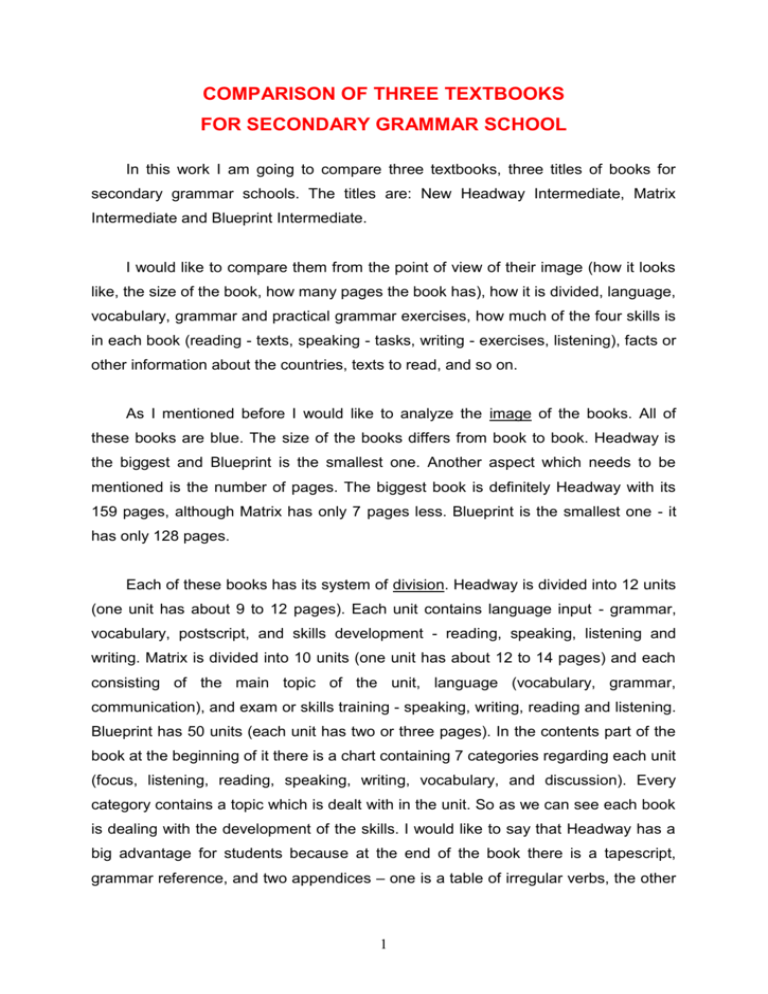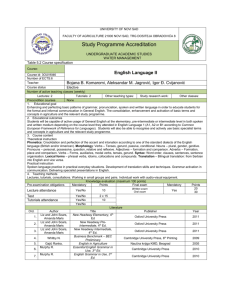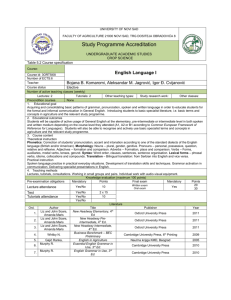Stiahnuť prednášku
advertisement

COMPARISON OF THREE TEXTBOOKS FOR SECONDARY GRAMMAR SCHOOL In this work I am going to compare three textbooks, three titles of books for secondary grammar schools. The titles are: New Headway Intermediate, Matrix Intermediate and Blueprint Intermediate. I would like to compare them from the point of view of their image (how it looks like, the size of the book, how many pages the book has), how it is divided, language, vocabulary, grammar and practical grammar exercises, how much of the four skills is in each book (reading - texts, speaking - tasks, writing - exercises, listening), facts or other information about the countries, texts to read, and so on. As I mentioned before I would like to analyze the image of the books. All of these books are blue. The size of the books differs from book to book. Headway is the biggest and Blueprint is the smallest one. Another aspect which needs to be mentioned is the number of pages. The biggest book is definitely Headway with its 159 pages, although Matrix has only 7 pages less. Blueprint is the smallest one - it has only 128 pages. Each of these books has its system of division. Headway is divided into 12 units (one unit has about 9 to 12 pages). Each unit contains language input - grammar, vocabulary, postscript, and skills development - reading, speaking, listening and writing. Matrix is divided into 10 units (one unit has about 12 to 14 pages) and each consisting of the main topic of the unit, language (vocabulary, grammar, communication), and exam or skills training - speaking, writing, reading and listening. Blueprint has 50 units (each unit has two or three pages). In the contents part of the book at the beginning of it there is a chart containing 7 categories regarding each unit (focus, listening, reading, speaking, writing, vocabulary, and discussion). Every category contains a topic which is dealt with in the unit. So as we can see each book is dealing with the development of the skills. I would like to say that Headway has a big advantage for students because at the end of the book there is a tapescript, grammar reference, and two appendices – one is a table of irregular verbs, the other 1 a table of verb patterns. On the last page there are phonetic symbols with examples of these vowels, diphthongs and consonants used. One small disadvantage of Headway is that you can not find a wordlist there as it is in Matrix. You need to buy or copy it from your teacher. The wordlist in Matrix is a well arranged handlist consisting of nouns, verbs, adjectives, phrasal verbs and idioms. The worst of all these books from the point of vies of the appendices, grammar reference and wordlist is Blueprint, because you can not find any of these things at the end of the book (in one place). In Blueprint the grammar is explained directly in the unit. Now I am going to deal with the language of these books. I consider Matrix the hardest one to understand, because there are a lot of unknown words, what is very good for students, because they will broaden their vocabulary. You can find there a lot of phrasal verbs and idioms, too. This is the only one from these three books that has a great number of such expressions. The language of Headway and Blueprint is easier, although it contains a lot of new and useful words (vocabulary). The vocabulary is very rich in all these books, and each of them has its own way of teaching the students. For example Matrix focuses on phrasal verbs, idioms and scarcely used words. Headway uses everyday expressions, but you can find there also some phrasal verbs but not as much as Matrix gives. In this next part, I would like to deal with the grammar and practical grammar exercises in each of these three textbooks. Blueprint explains the grammar in each unit (or set of units), and then there are exercises after each 5 units to practice the grammar. You can not find there a summary of the grammar on one place. The book Headway has its grammar explained at the end of the book in the grammar reference as I have mentioned before and it does not contain any revision exercise pages. You can see the exercises in the unit. These revision pages are not only seen in Blueprint, but also in Matrix. In Matrix we can find them immediately after each unit. The grammar is placed in the grammar reference at the end of the book. 2 When talking about the four skills in these textbooks I can say that they are very well developed. You can see it straightaway when you look into the contents of these books. Every one of them has speaking, writing, listening and reading skills included in each unit. For speaking there are many interesting topics to be spoken about. Writing skills develop not only the written expression but also the knowledge of writing an essay or a letter, whether formal or informal. You can also find exercises (texts) there where you just fill in the missing words and in such way you develop your reading and comprehension, vocabulary and knowledge about writing about similar topics or understanding the content of the text (facts about ESC, literature, ...). The comprehension of the students may be developed also by true or false activities, usually placed after the text or some statement or paragraph. Another very important aspect of the book is whether it contains some information about the English speaking countries - literature, facts - politics (law system etc.), education (different types of schools), some habits - eating habits, Christmas and Easter habits , monuments, famous places and artists (painters, actors, singers, writers, musicians, ...), and English and American common people. Headway contains quite interesting texts about famous writers (Agatha Christie), painters (Pablo Picasso), musicians (Scott Joplin), the varieties of English cuisine, an extract from David Copperfield by Charles Dickens, and about ordinary people (nanny, cook, gardener). Matrix offers texts about the Peak District, national characteristics, Empire State Building, New York, Cockney English, well known people (Elvis Presley, Albert Einstein, Charles Dickens etc.) and many more. Blueprint contains texts about Britain, sports, theatrical anecdotes, the musical “Cats”, the U.S. – the Empire State Building or about Agatha Christie. 3 In the conclusion I would like to present my opinion about which of these textbooks is the best for to teach from. Despite the fact that my opinion is not quite neutral as I learnt English with Headway I have to admit that Headway is pretty good. However, I would prefer Matrix to teach from. The grammar is well explained there and the exercises part offers a good back-up. The texts are interesting and support imagination and discussion among the students. The wordlist gives exact definitions from the Oxford Wordpower Dictionary for learners of English that are divided into groups of parts of speech, phrasal verbs and idioms, so the students can find the words easier. It is often the teacher’s hard task to choose the textbooks for his or her students and I would recommend taking Matrix into account, being a well composed mixture for all English learners. 4







